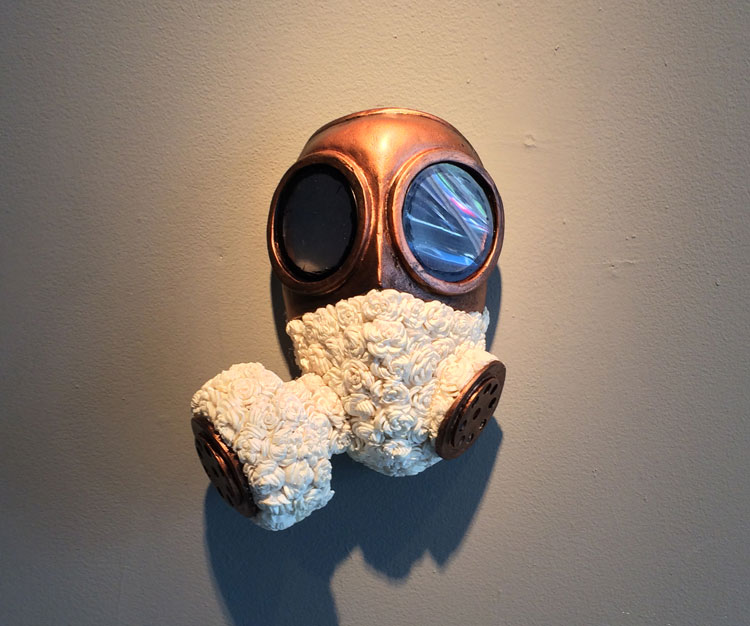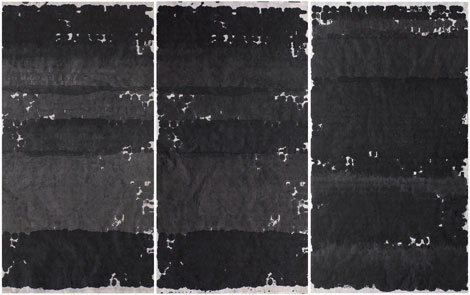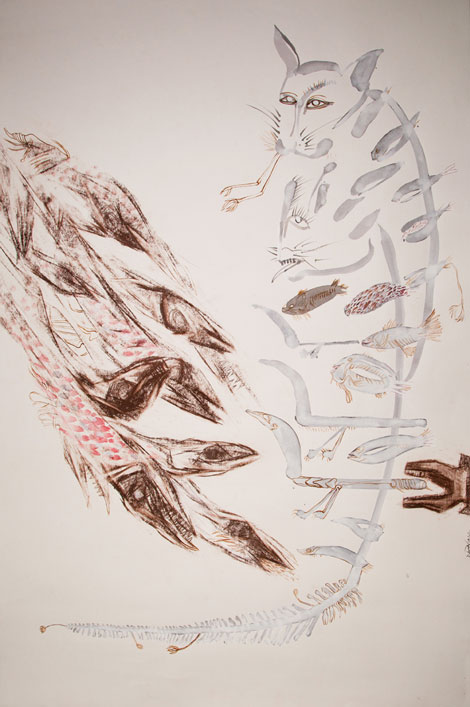Aicon Gallery’s first solo exhibition in New York of contemporary art from Bangladesh is off to a good start. Tilted “Readymade,” which consists of work by established and emerging artists compressed into a relatively short time frame that began after Bangladesh gained independence from Pakistan in 1971, displays an art scene edgy for its political content, talent and imagination.
Dhali Al Mamoon’s work in the foyer is an adequate litmus test of how to evaluate work from a new region. Mamoon is based in Chittagong, the northern region of Bangladesh, and is considered one of the pioneers of performance and installation art, in addition to being an established painter. His series of lead pencil drawings on paper, titled Lost Memory, is compelling for its rudimentary subject matter. Reminiscent of prehistoric birds, these spare rust-tinted skeletal figures reference mass killings during Bangladesh’s independence from Pakistan and become symbolic of a country and culture in its nascent stages. Sure-handed images of nature, beaks and reptilian remains echo the early phases of evolution from which all of humanity, regardless of caste or creed, emerged. Viewed in this context, human violence seems particularly savage-like, and Mamoon’s deft conception of abstract figuration makes the work all the more effective.
Genocide as an endemic part of Bangladesh history is the subject of Wakilur Rahman’s large ink on paper triptych, Genocide (2009). Uneven blotches of shaded black ink are interspersed with small white patches, making abstraction a powerful tool to pay homage to scores of forgotten people reduced to mere specks of memory. Rahman navigates contemporary connections such as displacement and community formation by way of a complex route between the past and the present.
Younger artists like Imran Hossain Piplu and Promotesh Das Pulak use weapons to reference history and denote the power of military rule long after independence. Piplu’s paintings that were a part of the first Bangladesh Pavilion at the Venice Biennale in 2013—depict skeletal guns and weapons of war as excavated fossils—while Pulak’s sculptural representations present war masks, hand grenades and Kalashnikovs (rifles) studded with white Shola paper flowers. Akin to much contemporary art from the Middle East, revolutionary art is pivotal to a country in the throes of cultural, economical and political change. Objection to bloodshed and the need to compel reformation are repeatedly manifested through Piplu’s reference to the deep-rootedness of violence and Pulak’s ironic consecration of its weapons through his sculpture.
For Khaled Hassan and Kazi Salahuddin Ahmed Bangladeshi, identity is addressed through trying current situations. Hassan’s digital prints portray unacknowledged, powerless immigrant workers surviving abroad in overcrowded living quarters. And Ahmed’s series of colorful geometric paintings of newspaper on canvas, titled Sheer Chaos, consists of abstract renderings of the rapidly changing cityscape as industrialization transforms the country forever.
In “Readymade,” the notion of establishing identity through history and current events is pivotal to their practice. Coming more than two decades after modernism took shape in the Indian Subcontinent, a variety of art forms express and authenticate the artists’ commitment to making art. Although distinctive in its look, be it Yasmin Jahan Nupur’s woven words of dreams or Mohammad Wahiduzzaman’s resin castings of exportable shirts, art from the region is evocative of larger emotions and a transcultural sensibility. Poised at the juncture of postcolonial expression, contemporary art from Bangladesh shows promise of heading in the right direction.
“Readymade ” ends Sept. 6, 2014
Aicon Gallery
35 Great Jones Street
New York, NY 10012
212-725-6092
newyork@aicongallery.com




